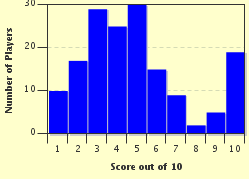Quiz Answer Key and Fun Facts
1. The word "hysteria" comes from the Greek word "hystera". How does this word translate into English?
2. One theory to explain symptoms which seemed specific to women was that of the "wandering womb". The idea was that the uterus was a floating organ and its displacement into the body caused several ailments. Who were the first to develop the "wandering womb" theory, several thousand years ago?
3. During the late Middle Ages and sometimes until the beginning of the Renaissance, which of the following - and unusual - treatment was prescribed to cure female hysteria?
4. During late Middle Ages and the early modern period (c. 1450-1700), many hot flashes, female sexual appetite, melancholia, or convulsions were seen as a sign of possession by the Devil and many women were accused of witchcraft. Which book, published in 1487, explained how to recognise - and hunt - witches?
5. In Victorian times, when the study of female hysteria reached its peak, which of the following was NOT prescribed against female hysteria?
6. During the 19th century, when female hysteria became a widely diagnosed condition, some doctors gave pelvic or vaginal "massages" to women as a treatment until the patients reached a "paroxysm". What was the doctors' general opinion of such treatment?
7. Sigmund Freud credited this precursor in neuroscience with demonstrating and defending the idea that hysteria could also be found in men, since the "disease", according to him, was neurological and therefore not linked to the uterus. What was his name?
8. In 1905, Sigmund Freud published "An Analysis of a Case of Hysteria" (known as "Dora", from the pseudonym given to the patient he studied), but he had already been studying hysteria for over a decade. How was Freud's approach different from other physicians' at the time?
9. By the 1960s and 1970s, many women philosphers and historians had developed their own theories about the origins of hysteria. What did they think caused hysteria?
10. When was the word "hysteria" removed from the manual of mental disorders by the American Psychiatric Association?
Source: Author
amidabutsu
This quiz was reviewed by FunTrivia editor
bloomsby before going online.
Any errors found in FunTrivia content are routinely corrected through our feedback system.

